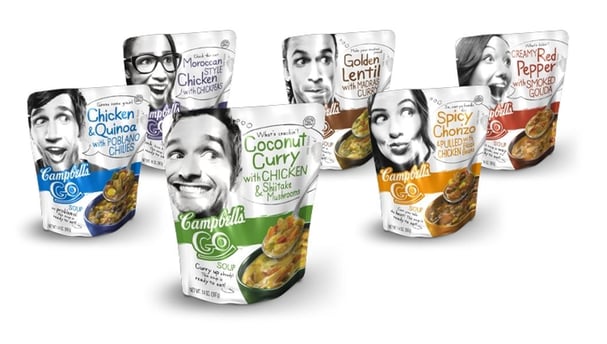 When most people think of Campbell’s soup, they think of the classic red-and-white label on a can, iconized by pop artist Andy Warhol, and seen in the pantries of many homes across the nation.
When most people think of Campbell’s soup, they think of the classic red-and-white label on a can, iconized by pop artist Andy Warhol, and seen in the pantries of many homes across the nation.
Although extremely identifiable and iconic, Campbell Soup Co. hasn’t been afraid to take chances, make changes, and completely overhaul its soup packaging to appeal to a younger, more hip generation. It’s certainly a risky move to introduce a new product into a type of soup packaging that looks completely different from what consumers are used to, but that’s exactly what brands like Campbell’s have done, and it’s allowed them to enter new markets and reach the largest living (i.e. most influential) generation.
While cans have their benefits, a vast majority of successful CPG companies are identifying the many advantages of flexible packaging to protect their products and build their brands. Stand up pouches, for example, are cheaper to transport and cost less to ship than heavy cans. They’re also significantly easier to open, requiring no additional tools (like a can opener), and they have the option of being resealed by the consumer with a zip lock to maintain freshness. Pouches are easy to take on the go, making them the perfect solution for busy professionals and students, and they can be produced in a wide range of sizes, structures, materials, and colors to best suit the product and its usages.
The world of pouches for soup packaging is highly innovative. Retort packaging allows consumers to pop the entire pouch of soup in the microwave to cook, which is crucial in an age when convenience matters. Pouches can also be manufactured with a pour spout, so consumers can easily remove the soup from the packaging and pour it into a pot, bowl, mug, etc. without hassle. Pouches are collapsible, making them significantly more landfill friendly than metal cans, and they can be recycled. Better yet, consumers can taste the difference in a product that has been packaged in a pouch made with layers of food-grade, FDA-approved barrier film versus a metal can.
We were recently asked the following question: "I want to package soup in stand up pouches. I know you use pressure canning for cans, what method do you use for pouches?"
This customer brought up a good point that many brands who haven’t made the switch from cans to pouches for soup packaging often consider… Will pouches actually maintain the shelf life of soup like the “old methods” have for decades?
There’s more to this than you’d think. Are you looking for the stand up bags to just contain the soup? Fill it hot, cool it down, and freeze/refrigerate it? Any number of film layers will work, depending on if you want a clear film (with window) or something opaque or metalized.
Now, if you are looking to cook in the bag, microwave or boil, a structure with nylon is key. However, some companies actually want to “cook” in the bag, in a retort (high- temperature cooking oven) pouch. This involves very unique film that can withstand the pressure and temperature, and this is referred to commonly as RCPP, or retort cast polypropylene.
The biggest advantage for brands considering taking a cue from Campbell’s and using stand up pouches for soup packaging is that customized options are almost endless. We always stress the importance of finding a packaging partner who will work and grow with you, rather than ordering random pouches from a faceless supplier. Your packaging partner will be able to provide samples for you to test your soup in at various temperatures, quantities, levels of viscosity, etc. You know how important it is to get good feedback from “taste testers” when developing and perfecting your food product, and the same goes for your packaging.
The best time to consider a new, convenient, and innovative type of packaging is now. Don’t wait until sales decline or your rigid packaging supplier falls through. Order samples, test, test, test, and maintain a communicative relationship with your flexible packaging partner to ensure the freshness, taste, and quality of your soup remains consistent from start to finish.






